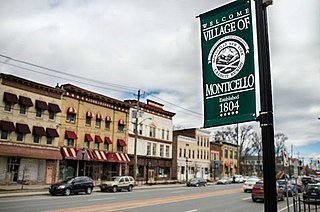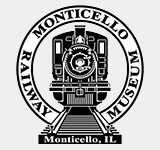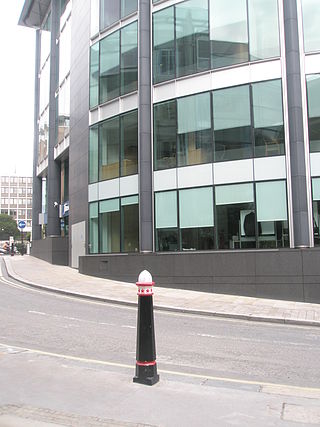
Holt is a market town, civil parish and electoral ward in the English county of Norfolk. The town is 22.8 miles (36.7 km) north of the city of Norwich, 9.5 miles (15.3 km) west of Cromer and 35 miles (56 km) east of King's Lynn. The town has a population of 3,550, rising and including the ward to 3,810 at the 2011 census. Holt is within the area covered by North Norfolk District Council. Holt has a heritage railway station; it is the south-western terminus of the preserved North Norfolk Railway, known as the Poppy Line.

Cherry Grove is a hamlet in the Town of Brookhaven, Suffolk County, New York, United States. It is located on Fire Island, a barrier island separated from the southern side of Long Island by the Great South Bay. The hamlet has approximately 300 houses on 41 acres (170,000 m2), a summer seasonal population of 2,000 and a year-round population of 15.

Monticello is a village located in Thompson, Sullivan County, within the Catskills region of New York, United States. The population was 7,173 at the 2020 census. It is the seat for the Town of Thompson and the county seat of Sullivan County. The village was named after the residence of Thomas Jefferson.
Monticello is the name of Thomas Jefferson's estate near Charlottesville, Virginia in the United States.

Sewells Point is a peninsula of land in the independent city of Norfolk, Virginia in the United States, located at the mouth of the salt-water port of Hampton Roads. Sewells Point is bordered by water on three sides, with Willoughby Bay to the north, Hampton Roads to the west, and the Lafayette River to the south. It is the site of Naval Station Norfolk.
The Battle of Sewell's Point was an inconclusive exchange of cannon fire between the Union gunboat USS Monticello, supported by the USS Thomas Freeborn, and Confederate batteries on Sewell's Point that took place on May 18, 19 and 21, 1861, in Norfolk County, Virginia in the early days of the American Civil War. Little damage was done to either side. By the end of April 1861, USS Cumberland and a small number of supporting ships were enforcing the Union blockade of the southeastern Virginia ports at the southern end of the Chesapeake Bay and had captured several ships which attempted to pass the blockade. USS Monticello's bombardment of the Sewell's Point battery was one of the earliest Union Navy actions against Confederate forces during the Civil War. While it has been suggested by some sources that the Monticello's action may have been the first gunfire by the Union Navy during the Civil War, a brief exchange of cannon fire between the U.S. gunboat USS Yankee and shore batteries manned by Virginia volunteer forces which had not yet been incorporated into the Confederate States Army at Gloucester Point, Virginia on the York River occurred on May 7, 1861.

The EMD SD40 is an American 6-axle diesel-electric locomotive built by General Motors Electro-Motive Division between January 1966 and August 1972. 1,268 locomotives were built between 1966 and 1972. In 1972, an improved version with new electronics was developed and marketed as a new locomotive, the SD40-2.

The Hotel Roanoke & Conference Center is a historic hotel located in the Gainsboro neighborhood of Roanoke, Virginia. Originally built in 1882, the hotel has been rebuilt and expanded many times. The central wing dates to 1938. The hotel is currently owned by Virginia Tech and operated under the Curio Collection by Hilton brand. It was added to the National Register of Historic Places in 1996.

Zaryadye is a historical district in Moscow established in 12th or 13th century within Kitai-gorod, between Varvarka Street and Moskva River. The name means "the place behind the rows", i.e., behind the market rows adjacent to the Red Square.

Jeffersonian architecture is an American form of Neo-Classicism and/or Neo-Palladianism embodied in the architectural designs of U.S. President and polymath Thomas Jefferson, after whom it is named. These include his home (Monticello), his retreat, the university he founded, and his designs for the homes of friends and political allies. More than a dozen private homes bearing his personal stamp still stand today. Jefferson's style was popular in the early American period at about the same time that the more mainstream Greek Revival architecture was also coming into vogue (1790s–1830s) with his assistance.

The Monticello Railway Museum is a non-profit railroad museum located in Monticello, Illinois, about 18 miles west of Champaign, IL. It is home to over 100 pieces of railroad equipment, including several restored diesel locomotives and cars.

The history of Norfolk, Virginia as a modern settlement begins in 1636. The city formally was incorporated in 1736. The city was burned by orders of the outgoing Virginia governor Lord Dunmore in 1776 during the second year of the American Revolutionary War (1775–1783), although it was soon rebuilt.

Downtown Norfolk serves as the traditional center of commerce, government, and culture in the Hampton Roads region. Norfolk, Virginia's downtown waterfront shipping and port activities historically played host to numerous and often noxious port and shipping-related uses. With the advent of containerized shipping in the mid-19th century, the shipping uses located on Norfolk's downtown waterfront became obsolete as larger and more modern port facilities opened elsewhere in the region. The vacant piers and cargo warehouses eventually became a blight on downtown and Norfolk's fortunes as a whole. But in the second half of the century, Norfolk had a vibrant retail community in its suburbs; companies like Smith & Welton, High's, Colonial Stores, Goldman's Shoes, Lerner Shops, Hofheimer's, Giant Open Air, Dollar Tree and K & K Toys were regional leaders in their respective fields. Norfolk was also the birthplace of Econo-Travel, now Econo Lodge, one of the nation's first discount motel chains.

The church of St Margaret Moses was a parish church which stood on the east side of Friday Street in the Bread Street ward of the City of London. It was destroyed in the Great Fire of London of 1666 and not rebuilt; instead the parish was united with that of St Mildred Bread Street.

St Mary Mounthaw or Mounthaut was a parish church in Old Fish Street Hill in the City of London. Of medieval origin, it was destroyed in the Great Fire of London in 1666 and not rebuilt.

Overlook Mountain is the southernmost peak of the Catskill Escarpment in the central Catskill Mountains near Woodstock, New York. The centerpiece of the 590-acre (240 ha) Overlook Mountain Wild Forest area of Catskill Park, the mountain is the site of one of the remaining five Catskill Mountain fire towers and the Overlook Mountain House, a hotel which was built at a higher elevation than any other in the range.

The Lisbon Inn, formerly The Moulton, is a historic former hotel building on United States Route 302 in Lisbon, New Hampshire. Located at the southern end of Lisbon's central business district, the 1901 three story wood-frame building is an imposing presence, with Queen Anne-style pyramidal roof turrets at the corners of the main facade. The front of the building has two stories of porches with Colonial Revival styling.
Monticello Hotel may refer to:
The following is a timeline of the history of the city of Norfolk, Virginia, United States.
The Phoenix Hotel was one of the most popular social spots in Dedham during the 19th century. It was located on the northwest corner of the High Street-Washington Street intersection in modern-day Dedham Square. Among the distinguished guests of this hotel were Andrew Jackson and James Monroe.


















